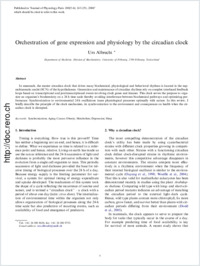Orchestration of gene expression and physiology by the circadian clock
- Albrecht, Urs Department of Medicine, Division of Biochemistry, University of Fribourg, Switzerland
-
08.07.2007
Published in:
- Journal of Physiology-Paris. - 2006, vol. 100, no. 5-6, p. 243-251
English
In mammals, the master circadian clock that drives many biochemical, physiological and behavioral rhythms is located in the suprachiasmatic nuclei (SCN) of the hypothalamus. Generation and maintenance of circadian rhythms rely on complex interlaced feedback loops based on transcriptional and posttranscriptional events involving clock genes and kinases. This clock serves the purpose to organize an organism’s biochemistry on a 24 h time scale thereby avoiding interference between biochemical pathways and optimizing performance. Synchronization to environmental 24 h oscillations tunes physiological processes optimally with nature. In this review, I briefly describe the principle of the clock mechanism, its synchronization to the environment and consequences on health when the circadian clock is disrupted.
- Faculty
- Faculté des sciences et de médecine
- Department
- Département de Biologie
- Language
-
- English
- Classification
- Biological sciences
- License
- License undefined
- Identifiers
-
- RERO DOC 9279
- DOI 10.1016/j.jphysparis.2007.05.004
- Persistent URL
- https://folia.unifr.ch/unifr/documents/300749
Statistics
Document views: 183
File downloads:
- albrecht_oge.pdf: 163
